Articles are updated now and then. Last Update
Right Click to download either images or sound files (in most browsers).
Advertising and Art from the Ragtime Era
Example of an early 20th century 24-color lithograph cigar box label with embossed gold foil.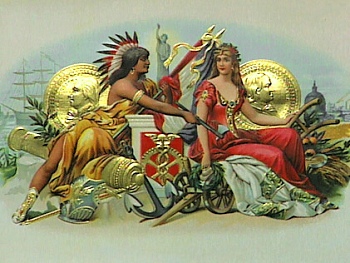 |
CIGAR BOXES
Even before the advent of colorful and attractive sheet music cover art, talented lithographers focused their attention on creating some of the most beautiful cigar boxes one could ever imagine. Lithography is an art that requires piecing together an image from stone cuts, and when dealing with color, this meant a stone for each layer of color that had to be perfectly aligned. Some of the more ornate boxes had as many as 24 different layers of absolute or mixed colors. Even with four colors they could create fairly realistic images. These images also extended to other forms of tobacco products, including chaw pouches, and even the cigar bands themselves.
Interestingly, one of the most prolific designers and printers of these products was the
August Hoen Company, which is known to ragtime enthusiasts as the company that produced the highly collectible
E.T. Paull sheet music covers. From the 1850s on these boxes, which covered as many themes as could be imagined, were considered collectibles. Some people had Currier and Ives prints around their homes, while some gentlemen preferred blondes - on cigar boxes. All of it served as a manner of advertising, and not just for the cigars, but for many non-tobacco companies who licensed cigars as promotional items, extra point of sale add-ons, or simply giveaways. Many of the finer companies have kept this artful tradition alive into the 21st century, but the content of many of these collectibles constitute some of the finest small-size lithographs ever made.
These kitties are singing the tune of the month - Cats on a Hot Tin Wall.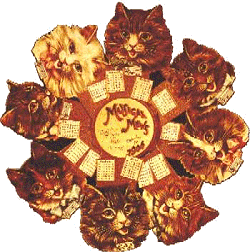 |
CALENDAR ART
In recent years we have had the now retired Far Side desk calendars, Dilbert virtual computer calendars, email calendar reminders, electronic PDAs, etc. They are all creative, but they are all rectangular as well. The one pictured here shows some welcome creativity and out-of-the-box thinking. It was one of many calendars printed by Rafael Tuck & Sons of England, a very successful printing firm of the era.
Actually, calendars, paper dolls, and postcards were among the most sought after gifts at this time. Many lithographers created beautiful fruit crates as well. Many were subsidized by advertising, a practice which spread quickly early in the 20th century. The calendars were all relatively inexpensive, but still priceless. Today we call them collectibles. Some of these calendars can bring hundreds of dollars in good condition. The best of them were formatted to work in any current year. And Grandma thought that the doggone thing was no longer useful come January First so she threw it out! This unique design featured one musical feline per month on rotating arms with limited movement. But this design also brings up an interesting question... how do you hang it on the refrig... umm... I mean, icebox?
RINGLING BROTHERS AND BARNUM AND BAILEY CIRCUS
This most famous of Circuses actually got its start through the originator of "The Greatest Show on Earth", well known swindler and con man
Phineas T. Barnum (1810-1891). Early in his career, which appropriately enough included a stint in state politics,
Vintage poster for "The Greatest Show On Earth"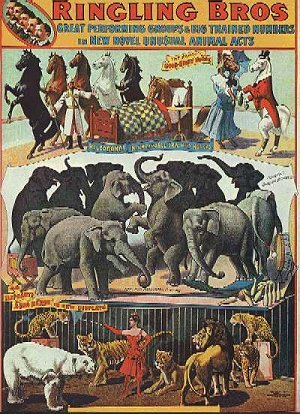 |
Barnum exhibited oddities from all over the world, eventually creating a freak show. Most of them were faked, such as little hairy "cave men" and "Siamese twins" (one of many terms he invented).
One of these fraudulent exploits helped to coin the most well known quote that he never said. Another exhibitor of the 1870's , David Hannum, had been deceived into buying an alleged petrified giant (actually a hunk of carved rock). Barnum wanted it so badly that when Hannum refused to sell it to him he created his own giant. He then claimed to have bought the original (they were both fakes), and people flocked to see Barnum's giant instead of Hannum's, based on reputation. It was Hannum who commented on this saying, "There's a sucker born every moment".
Barnum did create the P. T. Barnum Circus and later merged with the competing Bailey Circus. In the 1880's he purchased a huge bull elephant from the London Zoo named Jumbo. By exploiting the poor creature in his circus, he managed to add "Jumbo" to the lexicon as a synonym for large. After both he and Bailey died, yet another competing circus, the Ringling Brothers, bought the show to profit from its reputation. Thus the protracted name. It has since been unequivocally the most successful circus in the world. This is an early advertisement for the Ringling Brothers show in the days just before they merged with Barnum and Bailey. The posters were traditionally put up a week or more in advance of the arrival of the circus train, which was a major event in most towns. There was not just one operation, but several companies that were all part of the circus. This way they could cover more ground each season. Circuses have traditionally used marches and ragtime music as background for the past century. There are some fine CDs and iTunes downloads available that feature circus bands. A visit to the modern day Cole Brothers circus would give one a better idea of what these shows were like during the Ragtime Era.
NIPPER THE VICTOR DOG
OK. Get out your hankies for this one. So many of us have seen the ubiquitous image of "Nipper", the Victor Pooch, listening to a phonograph that is playing back his masters voice. However, why and under what circumstances is the rest of the story (apologies to the late
Paul Harvey).
Nipper listening for "His Masters Voice" on his master's coffin.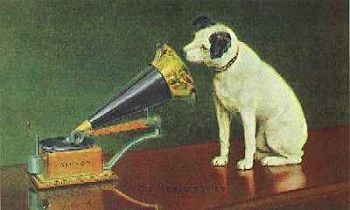 |
The original painting was partially finished in 1898 by British artist
Francis Barraud, who portrayed his brother's dog listening to "His Masters Voice" on an Edison cylinder phonograph that was placed on top of... grab your tissue... the coffin of his brother (the dog's master). Yes, Nipper, whom Francis had adopted following his brother's death, is listening to a voice from the grave. *tears*
It has been alleged that Barraud tried to sell the painting to
Thomas Edison for potential advertising purposes, and Edison summarily rejected it. He then went to the
Emile Berliner company and convinced a manger to purchase the work for their advertising with the promise of altering the displayed phonograph. The Edison player was painted over with a Berliner disc player, and both the painting and Nipper were patented in 1900 by Berliner. The following year, the newly formed
Victor Talking Machine Company purchased the rights to the painting and "Nipper" the dog, following lawsuits that led to Berliner's prohibition from selling his phonographs in the United States. Victor then altered the design to one that was less emotionally wrenching. It became instantly recognizable as their trademark, and was retained when the
Radio Corporation of America (RCA) purchased Victor in the late 1920s. The most recognizable dog in the world (next to Snoopy) was joined in the early 1990's by a digital pup name "Chipper", who is probably depicted listening to a voice from a dead iPod.
Poster for An American Bar in Paris.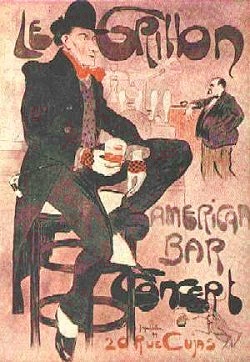 |
POSTER ART
Just like the U.S. has restaurants that feature cuisine and environment that are evocative of certain countries or cultures, there are, incredibly enough, restaurants in other countries that feature American cuisine (whatever that may be)! Actually, one of the most famous would be Rick's American Cafe, which is a focal point of the classic 1943 movie Casablanca. (Incidentally, Rick never said "Play it again Sam"; he said "You played it for her, you can play it for me." Another famous misquote debunked. As a rag pianist I have heard it more than I care to... but I digress.) This French poster comes from a popular genre of the early twentieth century, poster art. Many artists who could not sell their work otherwise were able to manage lithographs that could be sold as advertising or as souvenirs.
Ironically, many of these starving artists were Americans who had come to France to study art, and needed to sell some so they could afford passage back to America. They brought poster art back with them, and changed the nature of American advertising forever. Many of them were able secure jobs or contract to create sheet music covers, a big industry that helped to sell songs and rags for several years. The poster displayed here features an American style ragtime bar in Paris. The irony is that within a few years, bars of this nature would only exist in other countries, since prohibition of alcohol became American law for thirteen years starting in 1920. (For those that may know him, doesn't this guy look a lot like ragtime performer Max Morath?)
 |
The Ragtime Webring-Dedicated to Scott Joplin and the music of the Ragtime Era, this ring is an invaluable resource for jazz music lovers, musicians and historians. Sheet music, midi files, afro-american history, record collectors... |
|
|
Previous | Next | Random Site | Ring Hub | Add Your Ragtime Site | |
There are lots of great ragtime recordings by top artists available from

Including some of my recommended favorites:
And don't miss these movies which include some ragtime music:
|
|
Or just search their site using the search engine below!
|

|








 Loading Page. Please Wait...
Loading Page. Please Wait... 








